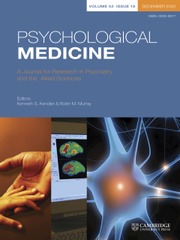Crossref Citations
This article has been cited by the following publications. This list is generated based on data provided by
Crossref.
Martin, Alexandra
and
Schmidt, Jennifer
2017.
Encyclopedia of Personality and Individual Differences.
p.
1.
Weerdmeester, Joanneke
van Rooij, Marieke
Harris, Owen
Smit, Niki
Engels, Rutger C.M.E
and
Granic, Isabela
2017.
Exploring the Role of Self-efficacy in Biofeedback Video Games.
p.
453.
Schmidt, Jennifer
and
Martin, Alexandra
2017.
Herzratenvariabilitäts-Biofeedback in der klinischen Praxis.
Psychotherapeut,
Vol. 62,
Issue. 6,
p.
498.
Stanton, Amelia M.
Hixon, J. Gregory
Nichols, Lindsey M.
and
Meston, Cindy M.
2018.
One Session of Autogenic Training Increases Acute Subjective Sexual Arousal in Premenopausal Women Reporting Sexual Arousal Problems.
The Journal of Sexual Medicine,
Vol. 15,
Issue. 1,
p.
64.
Keefer, Laurie
2018.
Behavioural medicine and gastrointestinal disorders: the promise of positive psychology.
Nature Reviews Gastroenterology & Hepatology,
Vol. 15,
Issue. 6,
p.
378.
Szulczewski, Mikołaj Tytus
and
Rynkiewicz, Andrzej
2018.
The effects of breathing at a frequency of 0.1 Hz on affective state, the cardiovascular system, and adequacy of ventilation.
Psychophysiology,
Vol. 55,
Issue. 12,
Narita, Yoshimi
Shinohara, Hitomi
and
Kodama, Hideya
2018.
Resting Heart Rate Variability and the Effects of Biofeedback Intervention in Women with Low-Risk Pregnancy and Prenatal Childbirth Fear.
Applied Psychophysiology and Biofeedback,
Vol. 43,
Issue. 2,
p.
113.
2018.
The Emerald Review of Industrial and Organizational Psychology.
p.
767.
Schäfer, Sarah K.
Ihmig, Frank R.
Lara H., Karen A.
Neurohr, Frank
Kiefer, Stephan
Staginnus, Marlene
Lass-Hennemann, Johanna
and
Michael, Tanja
2018.
Effects of heart rate variability biofeedback during exposure to fear-provoking stimuli within spider-fearful individuals: study protocol for a randomized controlled trial.
Trials,
Vol. 19,
Issue. 1,
Hösl, Katharina
Geiss, Lennard
and
Hillemacher, Thomas
2018.
Kardiovaskuläre autonome Dysfunktion bei psychischen Erkrankungen.
NeuroTransmitter,
Vol. 29,
Issue. 10,
p.
24.
Brabant, Olivier
and
Erkkilä, Jaakko
2018.
Enhancing improvisational music therapy through the addition of resonance frequency breathing: Common findings of three single-case experimental studies.
Music Therapy Perspectives,
Vol. 36,
Issue. 2,
p.
224.
Choi, Ahyoung
and
Shin, Hangsik
2018.
Quantitative Analysis of the Effect of an Ectopic Beat on the Heart Rate Variability in the Resting Condition.
Frontiers in Physiology,
Vol. 9,
Issue. ,
Shih, Chen-Hsuan (Iris)
Tomita, Naofumi
Lukic, Yanick X.
Reguera, Álvaro Hernández
Fleisch, Elgar
and
Kowatsch, Tobias
2019.
Breeze.
Proceedings of the ACM on Interactive, Mobile, Wearable and Ubiquitous Technologies,
Vol. 3,
Issue. 4,
p.
1.
王, 维
2019.
Review of Heart Rate Variability and Application Research.
Advances in Psychology,
Vol. 09,
Issue. 08,
p.
1510.
Hunkin, Hugh
King, Daniel L.
and
Zajac, Ian T.
2019.
Wearable devices as adjuncts in the treatment of anxiety‐related symptoms: A narrative review of five device modalities and implications for clinical practice..
Clinical Psychology: Science and Practice,
Vol. 26,
Issue. 3,
Burch, James B.
Alexander, Melannie
Balte, Pallavi
Sofge, Jameson
Winstead, James
Kothandaraman, Venkat
and
Ginsberg, J. P.
2019.
Shift Work and Heart Rate Variability Coherence: Pilot Study Among Nurses.
Applied Psychophysiology and Biofeedback,
Vol. 44,
Issue. 1,
p.
21.
Blase, Kees L.
and
van Waning, Adeline
2019.
Heart Rate Variability, Cortisol and Attention Focus During Shamatha Quiescence Meditation.
Applied Psychophysiology and Biofeedback,
Vol. 44,
Issue. 4,
p.
331.
Rockstroh, Christoph
Blum, Johannes
and
Göritz, Anja S.
2019.
Virtual reality in the application of heart rate variability biofeedback.
International Journal of Human-Computer Studies,
Vol. 130,
Issue. ,
p.
209.
Petrocchi, Nicola
and
Cheli, Simone
2019.
The social brain and heart rate variability: Implications for psychotherapy.
Psychology and Psychotherapy: Theory, Research and Practice,
Vol. 92,
Issue. 2,
p.
208.
Szulczewski, Mikołaj Tytus
2019.
An Anti-hyperventilation Instruction Decreases the Drop in End-tidal CO2 and Symptoms of Hyperventilation During Breathing at 0.1 Hz.
Applied Psychophysiology and Biofeedback,
Vol. 44,
Issue. 3,
p.
247.


